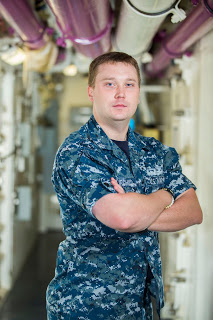A North Manchester native and 2009 North Manchester High School graduate is serving in the U.S. Navy aboard the service’s newest aircraft carrier USS Gerald R. Ford.
“I was taught hardwork and dedication I learned from growing up on a farm,” said Fairchild. “If you work hard every day you make life easier for yourself and give yourself more opportunities for success.”
Powerful catapults slingshot the aircraft off the bow of the ship. The planes land aboard the carrier by snagging a steel cable with an arresting hook that protrudes from the rear of the aircraft.
Ford is the first of a class of aircraft carriers that offer significant performance improvements over the previous Nimitz-class aircraft carriers. The ship is equipped with the Electromagnetic Aircraft Launch System (EMALS) to launch aircraft, rather than steam catapults currently used aboard other aircraft carriers, eliminating the requirement to generate and store steam for catapults, which frees up space. EMALS and other new systems and operating concepts will allow the Ford to accomplish 25 percent more aircraft launches per day than its predecessor while requiring 25 percent fewer crewmembers, resulting in an estimated savings of $4 billion in operating costs over a 50-year life span.
The ship is named after the 38th President of the United States, and U.S. Navy veteran, Gerald Rudolph Ford, Jr. After the attack on Pearl Harbor, Ford enlisted in the U.S. Naval reserve, serving from 1942 to 1946. While serving at Navy Preflight School in 1942 in Chapel Hill, North Carolina, he taught seamanship, ordnance, gunnery, first aid and military drill. At sea, Ford served aboard the light aircraft carrier, USS Monterey, which saw action in the Pacific throughout World War II. After the war, Ford left naval service, achieving the rank of lieutenant commander.
Continuing the traditions of those who served in World War II and since, a key element of the Navy the nation needs is tied to the fact that America is a maritime nation, meaning that the nation’s prosperity is tied to the ability to operate freely on the world’s oceans, according to Navy officials. More than 70 percent of the Earth’s surface is covered by water; 80 percent of the world’s population lives close to a coast; and 90 percent of all global trade by volume travels by sea.
Fairchild is playing an important part in America’s focus on rebuilding military readiness, strengthening alliances and reforming business practices in support of the National Defense Strategy.
“Our priorities center on people, capabilities and processes, and will be achieved by our focus on speed, value, results and partnerships,” said Secretary of the Navy Richard V. Spencer. “Readiness, lethality and modernization are the requirements driving these priorities.”
Though there are many ways for sailors to earn distinction in their command, community and career, Fairchild is most proud of being the first mass communication specialist to be meritoriously advanced aboard the ship.
“It was due to dedication and hard work which paid off,” said Fairchild. “I stayed humble after being advanced and continued to work hard.”
Serving in the Navy is a continuing tradition of military service for Fairchild, who has military ties with family members who have previously served. Fairchild is honored to carry on the family tradition.
“My great-grandfather served in the Marines,” said Fairchild. “His experience of being in during wartime was inspiring to me, and I wanted to have my own experiences.”
Sailors’ jobs are highly varied aboard the carrier. Approximately 2,600 men and women currently make up the ship’s crew, which keeps all parts of the aircraft carrier running smoothly — this includes everything from washing dishes and preparing meals to handling weaponry and maintaining the nuclear reactors. Another 2,500 men and women will form the air wing responsible for flying and maintaining the aircraft aboard the ship.
“Sailors are the lifeblood of any warship and the men and women of the USS Gerald R. Ford are the absolute best that our Navy has to offer,” said Capt. John J. Cummings, commanding officer of USS Gerald R. Ford. “Because of the work they do, Warship 78 sailors will take our ship over the horizon and answer our nation’s call in ways that have never been done before. Our sailors are strong, resilient, and truly embody our ship’s motto of ‘Integrity at the Helm.’”
Ford, like each of the Navy’s aircraft carriers, is designed for a 50-year service life. When the air wing is embarked, the ship will carry more than 70 attack jets, helicopters and other aircraft, all of which take off from, and land aboard the carrier at sea.
All of this makes Ford a self-contained mobile airport and strike platform, and often the first response to a global crisis because of a carrier’s ability to operate freely in international waters anywhere on the world’s oceans.
As a member of one of the U.S. Navy’s most relied upon capital assets, Fairchild and other Ford sailors know they are part of a legacy that will last beyond their lifetimes providing the Navy the nation needs.
“Having a proud family makes it all worth it with their support,” added Fairchild. “It’s very eye-opening and an inspiring experience to serve my country.”





